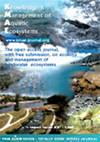Increasing fish diversity of Chicago's waterways
IF 1.7
3区 环境科学与生态学
Q3 FISHERIES
引用次数: 2
Abstract
Descriptions of shifts in biodiversity across time are desired for urban freshwater systems to better study ecosystem change and causal mechanisms. I document changes in fish diversity within the Chicago Area Waterways across 35 years using a battery of diversity metrics calculated on both abundance and biomass data. Has diversity of Chicago's waterways changed over 35 years and if so, do different diversity metrics exhibit different trends or breakpoints in trends? Diversity of the fish assemblage increased across the three decades of study. Breakpoint analysis suggested that trends across the timeseries were nonlinear. Changes in dominant species influenced behavior of less traditional metrics, whereas Margalef's Richness, Shannon-Weiner, and Gini-Simpson appeared more robust. Increases in richness and taxonomic diversity combined with decreases in species dominance suggest an ecosystem of increasing quality. The fish community of the Chicago Area Waterway System is more diverse both in abundance as well as biomass (i.e., energy flows) in the late 2010's than it was in the late 1980's. Although external factors related to wastewater treatment increased water quality and likely led to these assemblage-level changes breakpoint analysis did not allow verification of causal mechanisms.增加芝加哥水道鱼类的多样性
为了更好地研究城市淡水系统的生态系统变化及其因果机制,需要描述生物多样性随时间的变化。我记录了35年来芝加哥地区水道内鱼类多样性的变化,使用了一组基于丰度和生物量数据计算的多样性指标。在过去的35年里,芝加哥水道的多样性是否发生了变化?如果是这样,不同的多样性指标是否表现出不同的趋势或趋势的断点?在30年的研究中,鱼类组合的多样性增加了。断点分析表明,跨时间序列的趋势是非线性的。优势物种的变化影响了不太传统的度量标准的行为,而Margalef丰富度、Shannon-Weiner和Gini-Simpson则表现得更为稳健。丰富度和分类多样性的增加与物种优势度的下降相结合,表明生态系统的质量正在提高。2010年代末,芝加哥地区水路系统的鱼类群落在丰度和生物量(即能量流)方面都比1980年代末更加多样化。尽管与废水处理相关的外部因素增加了水质,并可能导致这些组合水平的变化,但断点分析无法验证因果机制。
本文章由计算机程序翻译,如有差异,请以英文原文为准。
求助全文
约1分钟内获得全文
求助全文
来源期刊

Knowledge and Management of Aquatic Ecosystems
环境科学-海洋与淡水生物学
CiteScore
3.70
自引率
5.60%
发文量
22
审稿时长
>12 weeks
期刊介绍:
Knowledge and Management of Aquatic Ecosystems (KMAE-Bulletin Français de la Pêche et de la Pisciculture since 1928) serves as a foundation for scientific advice across the broad spectrum of management and conservation issues related to freshwater ecosystems.
The journal publishes articles, short communications, reviews, comments and replies that contribute to a scientific understanding of freshwater ecosystems and the impact of human activities upon these systems. Its scope includes economic, social, and public administration studies, in so far as they are directly concerned with the management of freshwater ecosystems (e.g. European Water Framework Directive, USA Clean Water Act, Canadian Water Quality Guidelines, …) and prove of general interest to freshwater specialists. Papers on insular freshwater ecosystems and on transitional waters are welcome. KMAE is not a preferred journal for taxonomical, physiological, biological, toxicological studies, unless a clear link to ecological aspects can be established. Articles with a very descriptive content can be accepted if they are part of a broader ecological context.
 求助内容:
求助内容: 应助结果提醒方式:
应助结果提醒方式:


